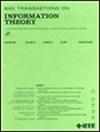Rényi Resolvability, Noise Stability, and Anti-Contractivity
IF 2.9
3区 计算机科学
Q3 COMPUTER SCIENCE, INFORMATION SYSTEMS
引用次数: 0
Abstract
This paper investigates three closely related topics—Rényi resolvability, noise stability, and anti-contractivity. The Rényi resolvability problem refers to approximating a target output distribution of a given channel in the Rényi divergence when the input is set to a function of a given uniform random variable. This problem for the Rényi parameter in (可解析性、噪声稳定性和抗收缩性
本文研究了三个密切相关的主题- rsamnyi可解析性,噪声稳定性和抗收缩性。rsamnyi可解性问题是指当输入被设置为给定均匀随机变量的函数时,在rsamnyi散度中逼近给定通道的目标输出分布。本文作者和Tan在2019年首次研究了($0,2]\cup \{\infty \}$)中r尼米参数的这个问题。在本文中,我们提供了一个完整的解决方案,在整个范围内的r逍遥参数$\mathbb {R}\cup \{\pm \infty \}$。然后,我们通过观察一个集合的q-稳定性的最大化或最小化等价于rsamnyi可解性问题的一个变体,将rsamnyi可解性问题与噪声稳定性问题联系起来。通过这种联系,我们给出了q稳定性的清晰的无量纲界。最后,我们将噪声稳定性问题与马尔可夫算子(即条件期望算子)的反收缩性联系起来,其中我们引入的术语“反收缩性”指的是众所周知的收缩性/超收缩性的相反性质。我们导出了尖锐的无量纲反收缩不等式。本文的所有结果都对二值分布进行了评估。本文的证明主要是基于类型的方法,特别是包覆引理的强化版本。
本文章由计算机程序翻译,如有差异,请以英文原文为准。
求助全文
约1分钟内获得全文
求助全文
来源期刊

IEEE Transactions on Information Theory
工程技术-工程:电子与电气
CiteScore
5.70
自引率
20.00%
发文量
514
审稿时长
12 months
期刊介绍:
The IEEE Transactions on Information Theory is a journal that publishes theoretical and experimental papers concerned with the transmission, processing, and utilization of information. The boundaries of acceptable subject matter are intentionally not sharply delimited. Rather, it is hoped that as the focus of research activity changes, a flexible policy will permit this Transactions to follow suit. Current appropriate topics are best reflected by recent Tables of Contents; they are summarized in the titles of editorial areas that appear on the inside front cover.
 求助内容:
求助内容: 应助结果提醒方式:
应助结果提醒方式:


